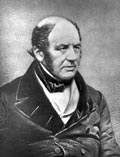Samuel A. Cartwright facts for kids
Quick facts for kids
Samuel A. Cartwright
|
|
|---|---|

Samuel Cartwright
|
|
| Born |
Samuel Adolphus Cartwright
November 3, 1793 |
| Died | May 2, 1863 (aged 69) |
| Nationality | American |
| Education | University of Pennsylvania School of Medicine |
| Occupation | Physician |
| Known for | Coining "drapetomania" |
| Spouse(s) | Mary Wren |
Samuel Adolphus Cartwright (November 3, 1793 – May 2, 1863) was an American physician who practiced in Mississippi and Louisiana in the antebellum United States. Cartwright is best known as the inventor of the 'mental illness' of drapetomania, the desire of a slave for freedom, and an outspoken critic of germ theory.
Contents
Biography
Cartwright married Mary Wren of Natchez, Mississippi, in 1825. During the American Civil War, he was a physician in the Confederate States Army and served in camps near Vicksburg and Port Hudson. He was assigned with improving the sanitary conditions for the soldiers.
Slavery
The Medical Association of Louisiana charged Cartwright with investigating "the diseases and physical peculiarities of the negro race". His report was delivered as a speech at its annual meeting on March 12, 1851, and published in its journal. The most sensationalistic portions of it, on drapetomania and dysaesthesia aethiopica, were reprinted in DeBow's Review. He subsequently prepared an abbreviated version, with sources cited, for Southern Medical Reports.
"If they nonetheless became dissatisfied with their condition, they should be whipped to prevent them from running away." In describing his theory and cure for drapetomania, Cartwright relied on passages of Christian scripture dealing with slavery.
Cartwright also invented another 'disorder', dysaesthesia aethiopica, a disease "affecting both mind and body." Cartwright used his theory to explain the perceived lack of work ethic among slaves. Dysaesthesia aethiopica, "called by overseers 'rascality'," was characterized by partial insensitivity of the skin and "so great a hebetude of the intellectual faculties, as to be like a person half asleep." Other symptoms included "lesions of the body discoverable to the medical observer, which are always present and sufficient to account for the symptoms."
According to Cartwright, dysaesthesia aethiopica was "much more prevalent among free negroes living in clusters by themselves, than among slaves on our plantations, and attacks only such slaves as live like free negroes in regard to diet, drinks, exercise, etc." — indeed, according to Cartwright, "nearly all [free negroes] are more or less afflicted with it, that have not got some white person to direct and to take care of them."
Cultural depictions
- Cartwright was referenced in the 2004 film C.S.A.: The Confederate States of America. In the film, after the Confederate States of America wins the American Civil War, Cartwright's work forms the basis for the fictional Cartwright Institute for Freedom Illnesses, a medical school incorporating his theory on drapetomania and other "negro peculiarities".
- Cartwright is also portrayed in the 1971 Mondo exploitation film Goodbye Uncle Tom alongside many other figures from the time. Notably, Cartwright is stated to be Jewish in the film, which he was not in reality.
See also
 In Spanish: Samuel A. Cartwright para niños
In Spanish: Samuel A. Cartwright para niños

